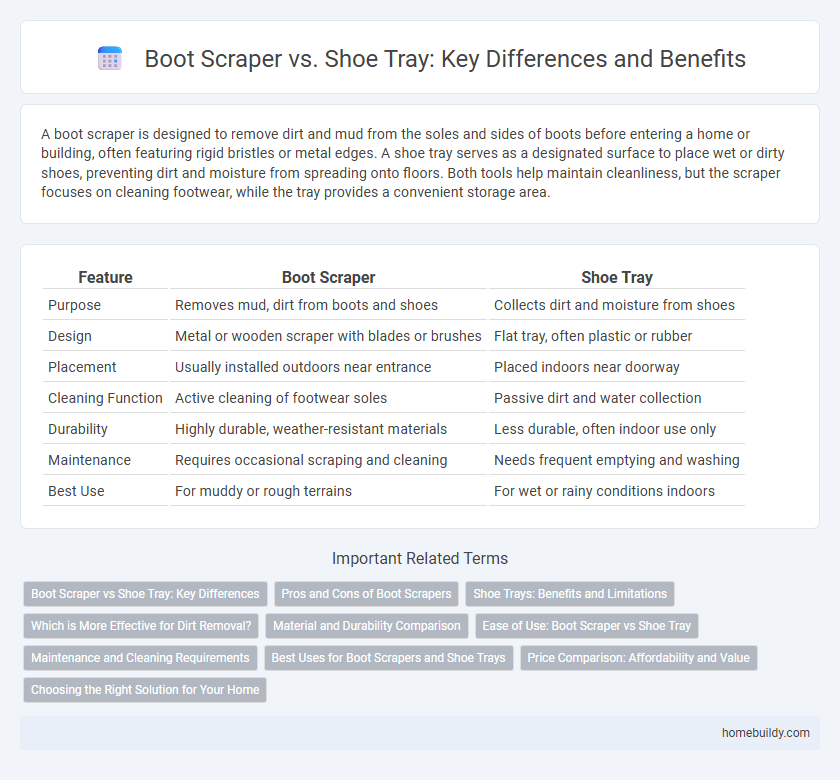A boot scraper is designed to remove dirt and mud from the soles and sides of boots before entering a home or building, often featuring rigid bristles or metal edges. A shoe tray serves as a designated surface to place wet or dirty shoes, preventing dirt and moisture from spreading onto floors. Both tools help maintain cleanliness, but the scraper focuses on cleaning footwear, while the tray provides a convenient storage area.
Table of Comparison
| Feature | Boot Scraper | Shoe Tray |
|---|---|---|
| Purpose | Removes mud, dirt from boots and shoes | Collects dirt and moisture from shoes |
| Design | Metal or wooden scraper with blades or brushes | Flat tray, often plastic or rubber |
| Placement | Usually installed outdoors near entrance | Placed indoors near doorway |
| Cleaning Function | Active cleaning of footwear soles | Passive dirt and water collection |
| Durability | Highly durable, weather-resistant materials | Less durable, often indoor use only |
| Maintenance | Requires occasional scraping and cleaning | Needs frequent emptying and washing |
| Best Use | For muddy or rough terrains | For wet or rainy conditions indoors |
Boot Scraper vs Shoe Tray: Key Differences
Boot scrapers are designed primarily to remove mud and debris from boots before entering a building, featuring rigid bristles or metal edges that efficiently scrape off dirt. Shoe trays serve as a catch-all surface to hold wet or dirty footwear and prevent water damage or dirt spread on floors, often made from waterproof materials like plastic or rubber. The key difference lies in function: boot scrapers actively clean footwear, while shoe trays act as containment zones for moisture and dirt.
Pros and Cons of Boot Scrapers
Boot scrapers effectively remove mud and debris from heavy boots, especially in rugged outdoor environments, ensuring cleaner footwear and reduced indoor dirt. They are typically more durable and weather-resistant than shoe trays, which mainly serve as containment for wet shoes but do not clean them. However, boot scrapers require manual effort and may not catch all small particles, whereas shoe trays help collect water and dirt passively but lack scrapping capability.
Shoe Trays: Benefits and Limitations
Shoe trays offer a convenient solution for containing dirt, moisture, and debris brought in by footwear, helping to protect indoor flooring and maintain cleanliness. Made from materials like plastic, rubber, or metal, they are lightweight, portable, and easy to clean, making them suitable for various entryways. However, shoe trays do not remove mud or heavy soil from boots or shoes, which can limit their effectiveness compared to boot scrapers designed specifically for thorough cleaning.
Which is More Effective for Dirt Removal?
Boot scrapers are more effective for removing thick mud and heavy debris due to their rigid metal bristles and sturdy design, which allow users to scrape off stubborn dirt before entering a home. Shoe trays, while helpful for collecting loose dirt and moisture, primarily serve as catchment areas and do not actively remove dirt from footwear. For thorough cleaning and preventing indoor mess, a boot scraper significantly outperforms a shoe tray in dirt removal efficiency.
Material and Durability Comparison
Boot scrapers are typically made from heavy-duty cast iron or steel, providing superior durability and resistance to weather conditions compared to shoe trays often constructed from plastic or lightweight rubber. The robust materials of boot scrapers ensure they withstand rigorous use and exposure to mud, snow, and dirt, while shoe trays may crack or degrade over time under similar conditions. The metal composition of boot scrapers offers a long-lasting, sturdy solution for outdoor footwear cleaning, surpassing the durability of most shoe trays designed primarily for indoor use.
Ease of Use: Boot Scraper vs Shoe Tray
Boot scrapers provide a quick and efficient way to remove mud and debris from boots using a simple scraping motion, making them highly convenient for outdoor use. Shoe trays require users to place shoes inside and may not effectively remove stuck dirt, often necessitating extra cleaning steps. The straightforward design of boot scrapers offers superior ease of use compared to shoe trays, especially in muddy or wet conditions.
Maintenance and Cleaning Requirements
Boot scrapers typically require minimal maintenance, needing only occasional removal of mud and debris with a brush to remain effective. Shoe trays, made from materials like plastic or rubber, demand regular cleaning to prevent water buildup and mold growth, often requiring washing or wiping. Both tools help maintain cleanliness, but boot scrapers offer a lower-maintenance option compared to the more upkeep-intensive shoe trays.
Best Uses for Boot Scrapers and Shoe Trays
Boot scrapers are ideal for removing heavy mud and debris from boots before entering a home, making them perfect for outdoor use in muddy or snowy environments. Shoe trays serve best for organizing and containing wet or dirty footwear indoors, protecting floors from water damage and dirt. Using boot scrapers at entrances paired with shoe trays inside provides a comprehensive solution for maintaining cleanliness and protecting flooring.
Price Comparison: Affordability and Value
Boot scrapers generally offer greater affordability compared to shoe trays, with typical prices ranging from $20 to $50, while shoe trays often cost between $30 and $70 depending on material and design. Despite the lower price, boot scrapers provide excellent value for removing mud and debris effectively, making them a practical choice for outdoor use. Shoe trays, although more expensive, add value by offering versatile moisture containment and storage benefits, appealing to users seeking a multipurpose solution.
Choosing the Right Solution for Your Home
Boot scrapers efficiently remove mud and debris from footwear, making them ideal for muddy or snowy environments, while shoe trays provide a clean, controlled area to store wet or dirty shoes indoors. Selecting the right solution depends on your home's entryway design and weather conditions, prioritizing functionality and ease of maintenance. Boot scrapers offer effective outdoor cleaning, whereas shoe trays help contain moisture and protect flooring inside.
Boot scraper vs Shoe Tray Infographic

 homebuildy.com
homebuildy.com